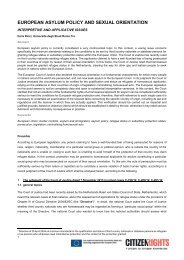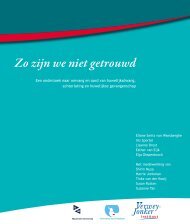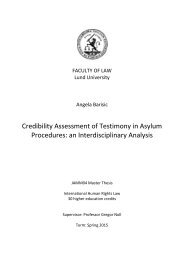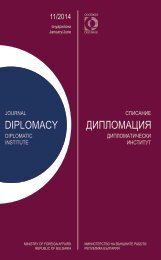AEMI
AEMI-2016-web
AEMI-2016-web
You also want an ePaper? Increase the reach of your titles
YUMPU automatically turns print PDFs into web optimized ePapers that Google loves.
22 <strong>AEMI</strong> JOURNAL 2015<br />
in his second report (Council of Europe,<br />
Office of the Commissioner for Human<br />
Rights 2006: 4-5 point 1: Protection of<br />
Minorities). In the latter, the commissioner<br />
also reported that the measures<br />
of the government for minority protection<br />
required additional investigation<br />
into the concept of ‘autochthonous’<br />
(primary) minorities and non-autochthonous<br />
(‘new’) minorities, and that<br />
the Framework Convention for the<br />
Protection of National Minorities also<br />
applies to groups of people who come<br />
from the other republics of the former<br />
Yugoslavia. The commissioner felt it was<br />
extremely important that the Slovenian<br />
government take measures to reduce the<br />
different levels of protection for Roma<br />
communities that emerge from the definition<br />
of these groups as either autochthonous<br />
or non-autochthonous, as the<br />
definition is still legally ambiguous. He<br />
was concerned that the use of these concepts<br />
caused legal and practical uncertainty<br />
and created the risk of arbitrary<br />
exclusion. As far as people from the republics<br />
of the former Yugoslavia were<br />
concerned, the commissioner expressed<br />
concern that they were not recognized<br />
as a minority in Slovenia, which caused<br />
great difficulty in terms of the preservation<br />
of language, faith, culture, and<br />
identity.<br />
The Slovenian government or, more<br />
precisely, the Ministry of Foreign Affairs<br />
defines its understanding of the concept<br />
of autochthonous minorities as follows<br />
(Republic of Slovenia, Ministry of Foreign<br />
Affairs 2006: 2): ‘By and large, we<br />
speak of autochthonous or historical settlements<br />
of certain communities in cases<br />
where such communities have been<br />
present in a certain area for at least two<br />
generations or more’ (emphasis added).<br />
Similarly, the Minority Rights Group<br />
stated in World Directory of Minorities<br />
(1990, xiv) that ethnic minorities become<br />
autochthonous after two generations<br />
(or in 40–50 years).<br />
This is the same interpretation implicitly<br />
recommended by the European<br />
Commissioner of Human Rights (Office<br />
of the Commissioner for Human<br />
Rights 2006: 3, comment f-5). But the<br />
use of the term in the Slovenian government<br />
documents is inconsistent to say<br />
the least, and at times even hypocritical.<br />
In international communication the<br />
Slovenian government uses the interpretation<br />
of the term as quoted above.<br />
But this definition of autochthonous<br />
minorities is not yet established in Slovenian<br />
internal documents. Most people<br />
who immigrated to Slovenia from<br />
other republics of the former Yugoslavia<br />
came during the 1970s and have dedicated<br />
the entirety of their active lives<br />
to the Slovenian economy and society.<br />
Moreover, the number of their second<br />
and third generation born in Slovenia<br />
now exceeds the number of first generation<br />
immigrants. Nevertheless, the<br />
Slovenian government in its internal<br />
documents continues to qualify this<br />
minority with the label ‘non-autochthonous,<br />
new ethnic communities’ or ‘new<br />
minority ethnic communities’ (Čurin<br />
Radovič 2002: 232). We find similar<br />
syntagms in other expert literature, for<br />
example ‘new ethnic/national communities’(Komac<br />
2003) and ‘new national<br />
minorities’(Medvešek and Vrečer 2005).<br />
By placing the label ‘new’ in quotation<br />
marks, some authors implicitly question<br />
the suggested non-autochthonous status<br />
of these communities. The danger exists









